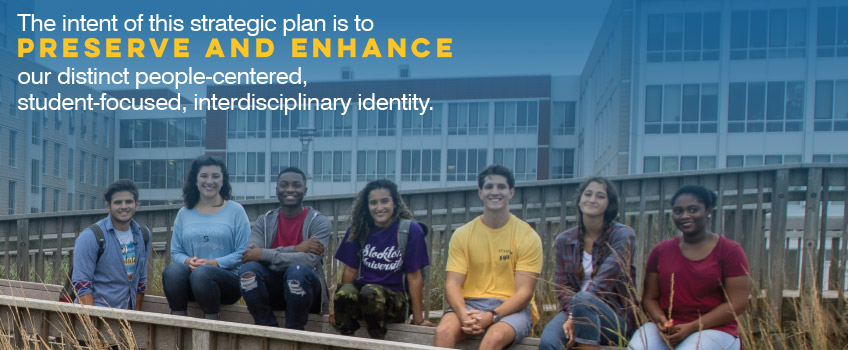Strategic Plan 2025 - Commitments

Prioritizing a State Education
New Jersey’s demographic projections suggest urgent action is needed to ensure the state’s future economic vitality. This is particularly true for southern New Jersey. Overall, the state’s population is projected to grow only 4.5% from 2014 to 2024; the rate for southern New Jersey is lower still, at 2.9%, and even this minimal growth is largely within the region’s older population.1 The number of high school students is slated to decrease 1.6% statewide (the highschool cohort projection is essentially flat for southern New Jersey).2 Finally, 56% of New Jersey high school seniors who enroll in college upon graduation currently leave the state to pursue higher education.3 New Jersey’s economic future depends on reversing this trend, and Stockton’s growth is a key part of the state’s strategy to provide compelling public higher education opportunities for its citizens. While Stockton alone cannot resolve the outmigration of New Jersey students, we are committed to strengthening our academic offerings and responsibly growing our enrollments in an intentional fashion to encourage more students to choose to study in their home state.
Committing to Diversity
While New Jersey’s high-school population is shrinking, its ethnic makeup is expanding, and will continue to do so in appreciable ways. Specifically, the state’s growth rates for those self-identifying as White is low at 1.7%, while the growth rates for historically underrepresented peoples are much higher: African-Americans at 7%, Hispanics at 15.8%, and Asians at 17.2%.4 Among high school students, these trends are more pronounced: White and African-American populations are both projected to decline (by 8.6% and 10.1% respectively) while the Hispanic and Asian populations will dramatically increase (by 47.4% and 33.3%).5
These changing demographics mean New Jersey’s institutions of higher education must provide a highquality undergraduate education to greater numbers of racial minorities, international immigrant populations, traditionally-underserved and socio-economically disadvantaged groups, and nontraditional (older) students. At Stockton, these groups have historically been small: only 30% of Stockton students identify as racial minorities, compared to an average of 55% at New Jersey’s four-year public higher education institutions. And only 13% of Stockton’s undergraduates are 25 or older (compared to an average of 21% for New Jersey’s four-year public higher education institutions and a nationwide average of 19%).6 The need to serve an increasingly diverse population requires Stockton to rethink how and where it recruits applicants (students, faculty, and staff), and how it supports them after they arrive on campus.
Anchoring Our Education
In 2016, the University participated in an historic Declaration of Commitment that launched an initiative to design and implement scalable and systematic change to communities across New Jersey. For Stockton this meant a concerted commitment to Atlantic City as an Anchor Institution.
The National Anchor Institutions Task Force defines anchor institutions as: enduring organizations that are rooted in their localities. It is difficult for them to leave their surroundings even in the midst of substantial capital flight. The challenge to a growing movement is to encourage these stable local assets to harness their resources in order to address critical issues such as education, economic opportunity, and health. It is difficult to imagine fragile local economies and widening social disparities changing without leveraging stable institutions, especially amidst a decline in government resources. These dynamics have given rise to the concept of “anchors” as agents of community and economic development.

A Generational Opportunity
Taken together, these three commitments—to public education, diversity and inclusion, and anchor activity in our communities—form a generational opportunity to re-imagine the egalitarian ethos prevalent at Stockton’s founding in the late 1960s in the context of today’s world.
The University’s founders faced the challenge of defining and implementing the Stockton Idea for a relatively small, singlecampus college. The task now is to determine how to build upon this idea, making it applicable to a much larger and more diverse student population at a multi-campus university.
This is not something to be undertaken lightly. It requires a highly-consultative, transparent, and data-informed process reflective of our commitment to shared governance. The intent of this strategic plan is therefore to preserve and enhance Stockton’s distinct people-centered, student-focused, interdisciplinary identity in the context of the modern, multicultural and interdependent world and the state’s economic and demographic realities.
1 Stockton University, Office of Institutional Research (2018). Impact Analysis Report. Changes in New Jersey Demographics, K-12 Schools and Postsecondary Enrollment and Potential Impact on Stockton’s Enrollment Management Efforts. Figure 10. (Original source: New Jersey Department of Labor and Workforce Development.)
2 Ibid.
3 National Center for Education Statistics (2018). Table 309.30.Residence and migration of all first-time degree/certificate-seeking undergraduates in 4-year degree-granting postsecondary institutions who graduated from high school in the previous 12 months, by state or jurisdiction: Fall 2016.https://nces.ed.gov/programs/digest/d17/tables/dt17_309.30. asp?current=yes
4 Stockton University, Office of Institutional Research (2018). Impact Analysis Report. Changes in New Jersey Demographics, K-12 Schools and Postsecondary Enrollment and Potential Impact on Stockton’s Enrollment Management Efforts. Figure 8. (Original source: New Jersey Department of Labor and Workforce Development.)
5 Ibid., figure 8.
6 Ibid. Figure 12. (Original source: New Jersey Department of Labor and Workforce Development and the New Jersey Office of the Secretary of Higher Education.)


